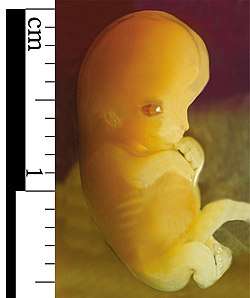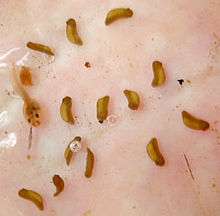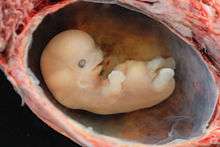Embryo
An embryo is an early stage of development of a multicellular organism. In general, in organisms that reproduce sexually, embryonic development refers to the portion of the life cycle that begins just after fertilization and continues through the formation of body structures, such as tissues and organs. Each embryo starts development as a zygote, a single cell resulting from the fusion of gametes (i.e. fertilization of a female egg cell by a male sperm cell). In the first stages of embryonic development, a single-celled zygote undergoes many rapid cell divisions, called cleavage, to form a blastula, which looks similar to a ball of cells. Next, the cells in a blastula-stage embryo start rearranging themselves into layers in a process called gastrulation. These layers will each give rise to different parts of the developing multicellular organism, such as the nervous system, connective tissue, and organs.
| Embryo | |
|---|---|
 A human embryo, seven weeks old or nine weeks' gestational age | |
| Identifiers | |
| MeSH | D004622 |
| TE | E1.0.2.6.4.0.8 |
| Anatomical terminology | |
A newly developing human is typically referred to as an embryo until the ninth week after conception (see human embryogenesis), when it is then referred to as a fetus. In other multicellular organisms, the word “embryo” can be used more broadly to any early developmental or life cycle stage prior to birth or hatching.
Etymology
First attested in English in the mid-14c., the word embryon derives from Medieval Latin embryo, itself from Greek ἔμβρυον (embruon), lit. "young one",[1] which is the neuter of ἔμβρυος (embruos), lit. "growing in",[2] from ἐν (en), "in"[3] and βρύω (bruō), "swell, be full";[4] the proper Latinized form of the Greek term would be embryum.
Development
Animal embryos

In animals, fertilization begins the process of embryonic development with the creation of a zygote, a single cell resulting from the fusion of gametes (e.g. egg and sperm).[5] The development of a zygote into a multicellular embryo proceeds through a series of recognizable stages, often divided into cleavage, blastula, gastrulation, and organogenesis.[6]
Cleavage is the period of rapid mitotic cell divisions that occur after fertilization. During cleavage, the overall size of the embryo does not change, but the size of individual cells decrease rapidly as they divide to increase the total number of cells.[7] Cleavage results in a blastula.[6]
Depending on the species, a blastula stage embryo can appear as a ball of cells on top of yolk, or as a hollow sphere of cells surrounding a middle cavity.[8] The embryo’s cells continue to divide and increase in number, while molecules within the cells such as RNAs and proteins actively promote key developmental processes such as gene expression, cell fate specification, and polarity.[9]
Gastrulation is the next phase of embryonic development, and involves the development of two or more layers of cells (germinal layers). Animals that form two layers (such as Cnidaria) are called diploblastic, and those that form three (most other animals, from flatworms to humans) are called triploblastic. During gastrulation of triploblastic animals, the three germinal layers that form are called the ectoderm, mesoderm, and endoderm.[8] All tissues and organs of a mature animal can trace their origin back to one of these layers.[10] For example, the ectoderm will give rise to the skin epidermis and the nervous system,[11] the mesoderm will give rise to the vascular system, muscles, bone, and connective tissues,[12] and the endoderm will give rise to organs of the digestive system and epithelium of the digestive system and respiratory system.[13][14] Many visible changes in embryonic structure happen throughout gastrulation as the cells that make up the different germ layers migrate and cause the previously round embryo to fold or invaginate into a cup-like appearance.[8]
Past gastrulation, an embryo continues to develop into a mature multicellular organism by forming structures necessary for life outside of the womb or egg. As the name suggests, organogenesis is the stage of embryonic development when organs form. During organogenesis, molecular and cellular interactions prompt certain populations of cells from the different germ layers to differentiate into organ-specific cell types.[15] For example, in neurogenesis, a subpopulation of cells from the ectoderm segregate from other cells and further specialize to become the brain, spinal cord, or peripheral nerves.[16]
The embryonic period varies from species to species. In human development, the term fetus is used instead of embryo after the ninth week after conception,[17] whereas in zebrafish, embryonic development is considered finished when a bone called the cleithrum becomes visible.[18] In animals that hatch from an egg, such as birds, a young animal is typically no longer referred to as an embryo once it has hatched. In vivaparous animals (animals whose offspring spend at least some time developing within a parent’s body), the offspring is typically referred to as an embryo while inside of the parent, and is no longer considered an embryo after birth or exit from the parent. However, the extent of development and growth accomplished while inside of an egg or parent varies significantly from species to species, so much so that the processes that take place after hatching or birth in one species may take place well before those events in another. Therefore, according to one textbook, it is common for scientists interpret the scope of embryology broadly as the study of the development of animals.[8]
Plant embryos

Flowering plants (angiosperms) create embryos after the fertilization of a haploid ovule by pollen. The DNA from the ovule and pollen combine to form a diploid, single-cell zygote that will develop into an embryo.[19] The zygote, which will divide multiple times as it progresses throughout embryonic development, is one part of a seed. Other seed components include the endosperm, which is tissue rich in nutrients that will help support the growing plant embryo, and the seed coat, which is a protective outer covering. The first cell division of a zygote is asymmetric, resulting in an embryo with one small cell (the apical cell) and one large cell (the basal cell).[20] The small, apical cell will eventually give rise to most of the structures of the mature plant, such as the stem, leaves, and roots.[21] The larger basal cell will give rise to the suspensor, which connects the embryo to the endosperm so that nutrients can pass between them.[20] The plant embryo cells continue to divide and progress through developmental stages named for their general appearance: globular, heart, and torpedo. In the globular stage, three basic tissue types (dermal, ground, and vascular) can be recognized.[20] The dermal tissue will give rise to the epidermis or outer covering of a plant,[22] ground tissue will give rise to inner plant material that functions in photosynthesis, resource storage, and physical support,[23] and vascular tissue will give rise to connective tissue like the xylem and phloem that transport fluid, nutrients, and minerals throughout the plant.[24] In heart stage, one or two cotyledons (embryonic leaves) will form. Meristems (centers of stem cell activity) develop during the torpedo stage, and will eventually produce many of the mature tissues of the adult plant throughout its life.[20] At the end of embryonic growth, the seed will usually go dormant until germination.[25] Once the embryo begins to germinate (grow out from the seed) and forms its first true leaf, it is called a seedling or plantlet.[26]
Plants that produce spores instead of seeds, like bryophytes and ferns, also produce embryos. In these plants, the embryo begins its existence attached to the inside of the archegonium on a parental gametophyte from which the egg cell was generated.[27] The inner wall of the archegonium lies in close contact with the "foot" of the developing embryo; this "foot" consists of a bulbous mass of cells at the base of the embryo which may receive nutrition from its parent gametophyte.[28] The structure and development of the rest of the embryo varies by group of plants.[29]
Since all land plants create embryos, they are collectively referred to as embryophytes (or by their scientific name, Embryophyta). This, along with other characteristics, distinguishes land plants from other types of plants, such as algae, which do not produce embryos.[30]
Research and technology
Embryos are used in various fields of research and in techniques of assisted reproductive technology. An egg may be fertilized in vitro and the resulting embryo may be frozen for later use. The potential of embryonic stem cell research, reproductive cloning, and germline engineering are currently being explored. Prenatal diagnosis or preimplantation diagnosis enables testing embryos for diseases or conditions.
Cryoconservation of animal genetic resources is a practice in which animal germplasms, such as embryos are collected and stored at low temperatures with the intent of conserving the genetic material.
The embryos of Arabidopsis thaliana have been used as a model to understand gene activation, patterning, and organogenesis of seed plants.[31]
In regards to research using human embryos, the ethics and legalities of this application continue to be debated.[32][33][34]
Researchers from MERLN Institute and the Hubrecht Institute in the Netherlands managed to grow samples of synthetic rodent embryoids, combining certain types of stem cells. This method may assist scientists to understand the very first moments of the process of the birth of a new life, which, in turn, can lead to the emergence of new effective methods to combat infertility and other genetic diseases.[35]
Fossilized embryos
Fossilized animal embryos are known from the Precambrian, and are found in great numbers during the Cambrian period. Even fossilized dinosaur embryos have been discovered.[36]
Miscarriage and abortion

Some embryos do not survive to the next stage of development. When this happens naturally, it is called spontaneous abortion or miscarriage.[37] There are many reasons why this may occur. The most common natural cause of miscarriage is chromosomal abnormality in animals[38] or genetic load in plants.[39]
In species which produce multiple embryos at the same time, miscarriage or abortion of some embryos can provide the remaining embryos with a greater share of maternal resources. This can also disturb the pregnancy, causing harm to the second embryo. Genetic strains which miscarry their embryos are the source of commercial seedless fruits.
Abortion is the process of artificially (non-naturally) removing the embryo through deliberate pharmaceutical or surgical methods.
See also
- In vitro fertilisation
- Plant embryogenesis
- Pregnancy
- Prenatal development
- Proembryo
Notes
- ἔμβρυον Archived 2013-05-31 at the Wayback Machine, Henry George Liddell, Robert Scott, A Greek-English Lexicon, on Perseus
- ἔμβρυος Archived 2013-05-31 at the Wayback Machine, Henry George Liddell, Robert Scott, A Greek-English Lexicon, on Perseus
- ἐν Archived 2013-05-31 at the Wayback Machine, Henry George Liddell, Robert Scott, A Greek-English Lexicon, on Perseus
- βρύω Archived 2013-05-31 at the Wayback Machine, Henry George Liddell, Robert Scott, A Greek-English Lexicon, on Perseus
- "24.6. Fertilization and Early Embryonic Development – Concepts of Biology – 1st Canadian Edition". opentextbc.ca. Retrieved 2019-10-30.
- Gilbert, Scott F. (2000). "The Circle of Life: The Stages of Animal Development". Developmental Biology. 6th Edition.
- "DevBio 11e". 11e.devbio.com. Retrieved 2019-11-07.
- Balinsky, Boris Ivan (1975). An Introduction to Embryology (Fourth ed.). W.B. Saunders Company. ISBN 0-7216-1518-X.
- Heasman, Janet (2006-04-01). "Patterning the early Xenopus embryo". Development. 133 (7): 1205–1217. doi:10.1242/dev.02304. ISSN 0950-1991. PMID 16527985.
- Favarolo, María Belén; López, Silvia L. (2018-12-01). "Notch signaling in the division of germ layers in bilaterian embryos". Mechanisms of Development. 154: 122–144. doi:10.1016/j.mod.2018.06.005. ISSN 0925-4773. PMID 29940277.
- "Ectoderm | The Embryo Project Encyclopedia". embryo.asu.edu. Retrieved 2019-11-07.
- "Mesoderm | The Embryo Project Encyclopedia". embryo.asu.edu. Retrieved 2019-11-07.
- Zorn, Aaron M.; Wells, James M. (2009). "Vertebrate Endoderm Development and Organ Formation". Annual Review of Cell and Developmental Biology. 25: 221–251. doi:10.1146/annurev.cellbio.042308.113344. ISSN 1081-0706. PMC 2861293. PMID 19575677.
- Nowotschin, Sonja; Hadjantonakis, Anna-Katerina; Campbell, Kyra (2019-06-01). "The endoderm: a divergent cell lineage with many commonalities". Development. 146 (11): dev150920. doi:10.1242/dev.150920. ISSN 0950-1991. PMC 6589075. PMID 31160415.
- "Process of Eukaryotic Embryonic Development | The Embryo Project Encyclopedia". embryo.asu.edu. Retrieved 2019-11-07.
- Hartenstein, Volker; Stollewerk, Angelika (2015-02-23). "The Evolution of Early Neurogenesis". Developmental Cell. 32 (4): 390–407. doi:10.1016/j.devcel.2015.02.004. ISSN 1534-5807. PMC 5987553. PMID 25710527.
- "Embryo vs. Fetus: The First 27 Weeks of Pregnancy". MedicineNet. Retrieved 2019-11-07.
- Kimmel, Charles B.; Ballard, William W.; Kimmel, Seth R.; Ullmann, Bonnie; Schilling, Thomas F. (1995). "Stages of embryonic development of the zebrafish". Developmental Dynamics. 203 (3): 253–310. doi:10.1002/aja.1002030302. ISSN 1097-0177. PMID 8589427.
- "seed | Form, Function, Dispersal, & Germination". Encyclopedia Britannica. Retrieved 2019-11-09.
- "Chapter 12A. Plant Development". biology.kenyon.edu. Retrieved 2019-11-09.
- Hove, Colette A. ten; Lu, Kuan-Ju; Weijers, Dolf (2015-02-01). "Building a plant: cell fate specification in the early Arabidopsis embryo". Development. 142 (3): 420–430. doi:10.1242/dev.111500. ISSN 0950-1991. PMID 25605778.
- "CK-12 Foundation". www.ck12.org. Retrieved 2019-11-09.
- "GLOSSARY G". www2.estrellamountain.edu. Retrieved 2019-11-09.
- Editors, B. D. (2018-05-21). "Vascular Tissue". Biology Dictionary. Retrieved 2019-11-09.
- Penfield, Steven (2017-09-11). "Seed dormancy and germination". Current Biology. 27 (17): R874–R878. doi:10.1016/j.cub.2017.05.050. ISSN 0960-9822. PMID 28898656.
- "Germination and Seedling Emergence". Forage Information System. 2016-03-28. Retrieved 2019-11-09.
- "Life Cycle - in a nutshell - bryophyte". www.anbg.gov.au. Retrieved 2019-11-14.
- "Plant development - Nutritional dependence of the embryo". Encyclopedia Britannica. Retrieved 2019-11-14.
- "Bryophytes – Biology 2e". opentextbc.ca. Retrieved 2019-11-14.
- "What are seaweeds?". formosa.ntm.gov.tw. Retrieved 2019-11-09.
- Boscá, S; Knauer, S; Laux, T (2011). "Embryonic development in Arabidopsis thaliana: from the zygote division to the shoot meristem". Frontiers in Plant Science. 2: 93. doi:10.3389/fpls.2011.00093. PMC 3355580. PMID 22639618.
- Freedman, Jeri. "America Debates Stem Cell Research." New York, NY: The Rosen Publishing Group, 2008.
- Sandel, Michael J. "The Case Against Perfection." Michael J. Sandel, 2007.
- Zavos, Panayiotis. "Reproductive Cloning is Moral." Ed. James Woodward. The Ethics of Human Cloning: At Issue. Farmington Hills, MI: Greenhaven, 2005. 14–24.
- "Scientists grow synthetic mouse embryos from stem cells" Archived 2018-05-08 at the Wayback Machine New Atlas, May 4, 2018
- Morelle, Rebecca. "Dinosaur embryo fossils reveal life inside the egg". BBC News. Archived from the original on 24 September 2015. Retrieved 8 August 2015.
- miscarriage "Miscarriage | Definition of Miscarriage by Lexico". Archived from the original on 2016-05-12. Retrieved 2016-05-15.
- Conrad Stöppler, Melissa. Shiel Jr., William C. (ed.). "Miscarriage (Spontaneous Abortion)". MedicineNet.com. Archived from the original on 2004-08-29. Retrieved 2009-04-07.
- Kärkkäinen, Katri; Savolainen, Outi; Koski, Veikko (1999). "Why do plants abort so many developing seeds: bad offspring or bad maternal genotypes?". Evolutionary Ecology. 13 (3): 305–317. doi:10.1023/A:1006746900736.
External links
| Wikimedia Commons has media related to Embryos. |
| Wikiquote has quotations related to: Embryo |
- UNSW Embryology - Educational website
- A Comparative Embryology Gallery
- 4-H Embryology, University of Nebraska-Lincoln Extension in Lancaster County
- Video with embryo of a small-spotted catshark inside the egg on YouTube
| Preceded by Zygote |
Animal development Embryo |
Succeeded by Fetus, Hatchling, Larva |